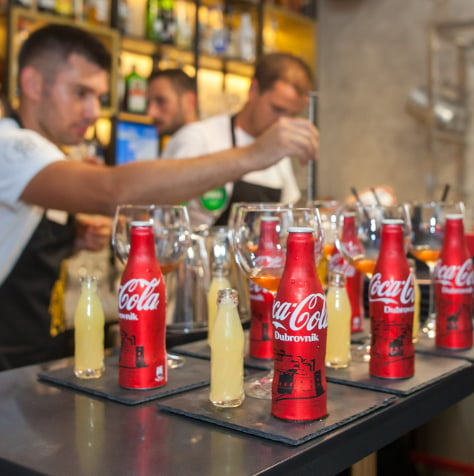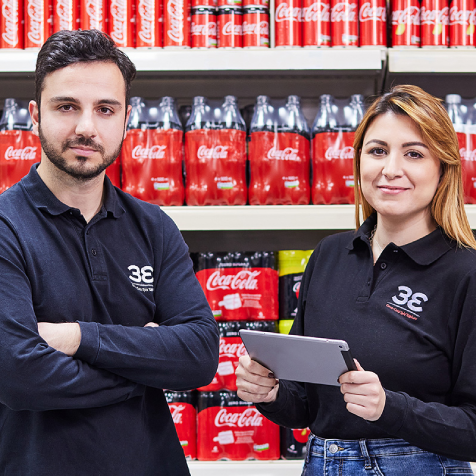We strive to minimise food loss and food waste in our operations as this helps us preserve water and other natural resources, avoid carbon emissions and mitigate the social and economic impacts of agriculture.
Food waste and loss targets
Our target to tackle food waste and loss across our activities and operations is:
- to decrease our absolute food losses (in dry matter) by 30% by 2025 compared to our 2019 baseline despite volume growth, an increase in portfolio/beverage categories, and expansion to emerging markets, and further reduce by 40% by 2030 vs. 2019.
Food loss and waste coming at our manufacturing sites are part of the overall waste management process. We strive to reach 100% recycled waste and have zero waste to landfill. We have reduced the percentage of manufacturing waste going to landfill significantly: in 2024, only 1.6% of our manufacturing waste went to landfill, while in 2015 it was 10.1% (this means in 2024 98.4% of total manufacturing waste was recycled or used for alternative usage).
To achieve our waste reduction targets, we apply the waste hierarchy principles (waste pyramid): prevent/avoid, reduce, reuse, recycle, recover, waste disposal.
Programmes and processes to prevent, avoid and minimise food waste and loss
Our aim is to ensure efficient use and control of raw and packaging materials, and our operations in order to minimise all losses and waste, including food. It starts with the demand and supply chain planning process, batch management and traceability of the materials and products, quality control of all materials, semi-finished and finished products, control of the non-conforming products, inventory management across the value chain, engagement with suppliers, customers, distributors, co-packers, and other partners.
Within production efficiency management, our teams on the production floor are measuring and analysing the losses from their production lines and the overall line efficiency on a daily basis, using this knowledge to set actions for improvement.
Expired products are the biggest part of the food loss we generate. To minimise them, we have introduced a process called product age management. It allows us to set up a goal for each stage of the product life cycle. In the marketplace, with the Product Freshness programme, we control the expiry date and age of our products and thus minimise food waste and finish goods write off. We check and monitor the age and take measures at sales area and customer level.
We monitor the product age in our warehouses on a monthly basis, then we follow up the delivery age of the products with our customers and we monitor our product age (whether the products are within their defined primary age or expired) on customers’ shelves monthly as a last point of our checks. This gives us good insights on product rotation time, leads to improved planning of the product age at every step, and reduces the amount of expired products in the marketplace.
As we have implemented warehouse age monitoring on a monthly basis, and Total Age Management (TAM), we now have the opportunity to control our food loss and waste through S&OP (Sales and Operations Planning) meetings, where products in warehouses close to expiration can be managed to avoid food waste through specific promotions, product sampling, internal consumption or charity donation.
Also based on market insights and demand levels, we can adjust our productions in the direction of food waste and loss avoidance through effective planning and sales processes.
Food waste and loss measuring
At production sites (plant level), we measure and separately collect each type of food loss (raw materials, manufacturing process, warehouse activities, storage, transportation). Each category of food loss is recorded in our specialised software and monitored at least monthly.
At the retail level (our customers), we measure the age of every finished good with our Total Age Monitoring (TAM) programme, and we take measures to avoid expired products.
Food waste and loss reporting and performance review
We utilise our Enterprise Resource Planning (ERP) system for reporting the food losses/waste. It is part of the overall business loss software solution. All food losses/waste are traced monthly, per country and per reason. More than 20 different reasons are assigned in our system for any business loss, and we use these reason codes for performing a deep analysis. As part of the monthly performance review, every function evaluates the absolute number of losses (in units and monetary terms), its percentage against the total volume of product sold, the trend vs. the last reporting period and vs. target, the reasons and root causes, and develops action plans for reduction. Annual targets are set at the country level.
Alternative use
In case food waste from expired products is unavoidable, we evaluate if these products are fit for human consumption and we work with different charity organisations and partners to redistribute them, such as FoodCloud, Fareshare and the Red Cross.
Here are some examples of what we’re doing:
- Across the island of Ireland, we are partnering with FoodCloud and FareShare to introduce a new food sourcing strategy to reduce food waste and double the volume of food redistributed in Ireland to 5,100 tonnes annually by 2025, preventing 16,000 tonnes of CO2e and providing approximately 12 million meals.
- In Italy, we donated over 1 million litres of beverages nearing expiry date to Banco Alimentare (Italian Food Bank) who distributed them to those in need.
- In Lithuania, we aid Maisto Bankas, offering beverages to low-income families and social risk families.
- In Hungary, we joined the World Food Day Convoy, for the eighth time, delivering 30 tonnes to families in need. We also partner with the Hungarian Food Bank Association to minimise food waste while supporting our communities.
- In the Czech Republic and Slovakia, we have donated more than 760,000 litres of beverages to food banks through partnerships with local organisations.
- In Switzerland, through our ongoing collaboration with Tischlein deck dich, we distributed over 200,000 litres of beverages nearing expiry to those affected by poverty.
If products cannot be used for human consumption, they go through anaerobic digestion, either in our own wastewater treatment facilities or at external wastewater treatment facilities. The product is crushed, with the liquid part recycled (treated to the levels supporting aquatic life) and the remaining part (sludge, which is the dry food loss), after further treatment, used for alternative purposes such as composting for agricultural needs or incineration for energy recovery and biogas/biofuel.
To view data for all years, scroll to the right using the scroll bar at the bottom of the table.
| Food loss and waste data1 |
2019 |
2020
|
2021
|
2022 |
2023 |
20241 |
Target 2024 |
Target 2025
|
Target 2030
|
| Total weight of food loss and waste with water content (no conversion to dry matter) (tonnes) |
54,154 |
42,077 |
32,390 |
32,139 |
38,742 |
44,538 |
|
|
|
| Avoided2 food waste (redistributed for human consumption) in dry matter (tonnes) |
|
|
25 |
126 |
264 |
153 |
|
|
|
Total weight of all food loss and waste in dry matter (tonnes)
|
5,445
|
4,320
|
3,343
|
2,193 |
2,371 |
2,581 |
<3,267 |
30% reduction
vs. 2019
(3,812 tonnes)
|
40% reduction
vs. 2019
(3,267 tonnes)
|
Total weight of food loss and waste used for alternative purposes (in dry matter) (tonnes)
|
1,462
|
1,572
|
1,433
|
1,432 |
1,709 |
1,733 |
|
|
|
Redistributed for anaerobic congestion
(on-site waste water treatment or external waste water treatment) (tonnes)
|
132 |
147 |
134 |
295 |
1,147 |
1,115 |
|
|
|
Redistributed for land application (composting) (tonnes)
|
214 |
455 |
158 |
145 |
111 |
172 |
|
|
|
Redistributed for energy recovery (biogas/biofuel) (tonnes)
|
1,117 |
969 |
1,142 |
992 |
451 |
446 |
|
|
|
Food loss/waste intensity (tonnes per tonne of product sold)
|
0.00047
|
0.00039
|
0.00027
|
0.00018 |
0.000183 |
0.00019 |
<0.01 |
|
|
1 Egypt acquisition done in January 2022 is excluded in years 2019 to 2023. Since 2024 the Egyptian data is included.
2 Redistribution for human consumption - products close to expiry date, not food waste.
3 Corrected formulae in 2024 (instead of 0.00017 the correct figure is 0.00018). |







